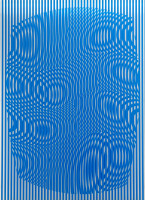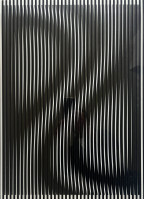


Details
Artist
Styles
Double screenprint // Rilievo ottico cinetico by Alberto Biasi is a limited edition screen-print from 1972, demonstrating the artist's mastery in optical and kinetic art. The composition uses geometric patterns and repetitive lines to create an illusion of movement and depth. The intricate interplay of green and purple hues enhances the visual effect, making the forms appear dynamic as the viewer’s perspective shifts. Biasi’s work exemplifies the Op Art movement, exploring visual perception and how simple linear elements can manipulate spatial perception.
Rilievo ottico cinetico, 1972
form
Medium
Size
63 x 63 cm
- Inches
- Centimeters
Edition
Price
- USD
- EUR
- GBP
Details
Artist
Styles
Double screenprint // Rilievo ottico cinetico by Alberto Biasi is a limited edition screen-print from 1972, demonstrating the artist's mastery in optical and kinetic art. The composition uses geometric patterns and repetitive lines to create an illusion of movement and depth. The intricate interplay of green and purple hues enhances the visual effect, making the forms appear dynamic as the viewer’s perspective shifts. Biasi’s work exemplifies the Op Art movement, exploring visual perception and how simple linear elements can manipulate spatial perception.
- Recently Added
- Price (low-high )
- Price (high-low )
- Year (low-high )
- Year (high-low )
What is Op Art?
Op Art is a visual art style that uses optical illusions to create the impression of movement, vibrating patterns, flashing, or hidden images. The works are typically abstract, with many well-known pieces in black and white. The roots of Op Art can be traced back to earlier movements like Futurism, Constructivism, Dada, and Neo-Impressionism, particularly in their use of color effects and graphic design.

















